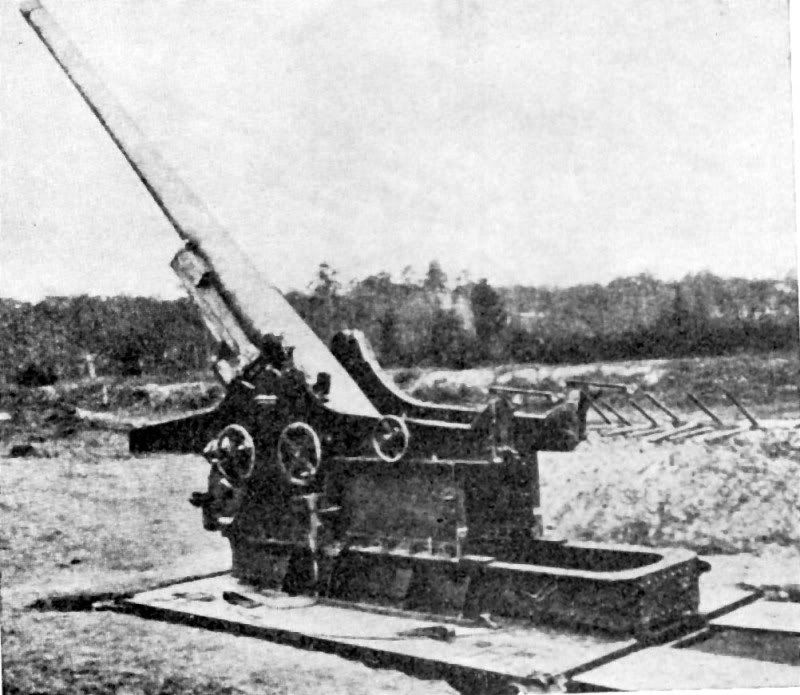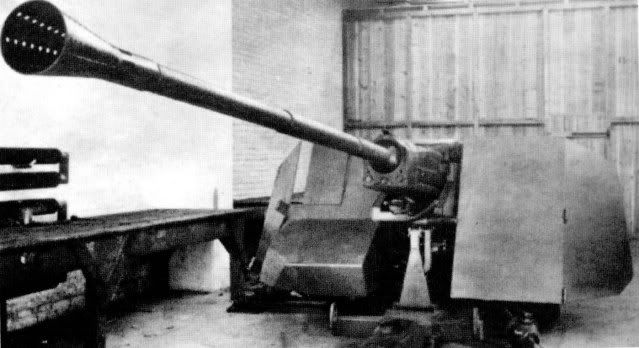Thank you for a really intriguing enigma and your kind words, Mr Librarian!
And now, without further ado, I give you this nice little piece to ponder upon:


Thank you for a really intriguing enigma and your kind words, Mr Librarian!
And now, without further ado, I give you this nice little piece to ponder upon:

Holly smoke - combined AA & AT gun Semag M 1923 (20 mm)! :shock:
Very original weapon, my dear Mr. Wingsofwrath, you really do have an imaginative taste in weaponry. Good! You will excuse me for a moment, I have to find something suitable as well. 
And finally, honorable ladies and gentlemen, here is another mysterious high-power piece of weaponry:

Thanking you in anticipation of your kind offers in the matter, I wish you, as always all the best! 
I’m afraid I am unable to crack this mystery in a single go, since this artillery piece is completely unknown to me, but I will try to break this enigma into (hopefully) more manageable pieces.
It’s clear this is gun is on a test mount of some sorts rather than its regular carriage - it seems a rather ill fit for the piece and would have proved damned impossible to move anywhere on the battlefield with that strong concrete base, so I’m guessing it’s either of the following:
a) prototype being tested by the army - this either resulted in the piece being adopted with/without modification, or in its rejection, in which case we are dealing with a one-off.
b) a captured piece of ordnance being tested in order to ascertain its characteristics.
The gun tube itself is strongly reminiscent in its shape of the Japanese Type 92 10 cm Cannon, although the exact caliber is somewhat hard to ascertain from the photograph due to the lack of any reference frame.
Both science and art rely upon intuition and perception, my dear Mr. Wingsofwrath. Although no one has yet been able to construct an fully acceptable explanation of how judgments are made, it is clear, however, that the way how man recognizes his environment has much to do with the prevailing attitudes he already has.
Therefore here are some additional hints:
Our heavy artillery piece actually has a 360-degree traverse(the bedding actually contained the traversing ring);
That long-range gun was completely transportable in disassembled state, separated into 3 independent loads;
Caliber was 150 mm;
Limited number of cannons was manufactured for export only.
With humility I acknowledge your very practical, sharp and encouraging inductive reasoning. :army: 
Well, so far, this has been a total no-brainer from my part - I got so fixed up on the similarity of the tube to the Japanese Type 92, I completely ignored the distinctive mount. I knew I’ve seen it before, but I couldn’t place it…
Well, a few minutes ago it hit me - I had seen a similar base in the Military Museum of Bucharest, holding up a Skoda 42mm Morser.
Following up that line of reasoning, I feel confident that the mystery piece of ordnance is in fact the 15 cm Kanone 403 (j), or, if you prefer, the Skoda 15cm M-1928 gun, used by Yugoslavia in the first part of the war and then captured by the Deutsche Heer and renamed in accordance. Ironically, the description of this gun states that it was also used by Romania, but I can attest to the fact that my country never had it in its arsenal and it’s probably just a confusion with the 75mm Skoda Md 1928 which we did use during the war.
What can I say, my dear Mr. Wingsofwrath? Your effort was absolutely splendid! What a gift you have. My sincerest congratulations upon your clear victory, won by the best man, and warmest wishes for your future success. 
I thank you very much for your praise, my dear Mr Librarian, but I must confess I am hardly deserving of it, considering how I consistently failed to see the right answer even though it was staring me right in the face.
In any case, allow me to introduce you to the next enigma, also a high powered piece of artillery:

Many people don’t recognize their true capability, my dear Mr. Wingsofwrath. However, I am assuring you that your identification abilities are significantly above the usual line. And remember: there is no man living who isn’t capable of doing more than he thinks he can do! Therefore, do believe in your strength and learn to repeat endlessly to yourself. “It all depends on me.” 
And now back to business! All visible elements are strongly suggesting that we are observing Soviet B4 M1931 (203mm) heavy howitzer.
Bravo!
I am really impressed with your speedy identification of this piece my dear Mr Librarian!
I took care to choose a picture in which the specific caterpillar tracks of this heavy howitzer are not visible, and yet you managed to spot it right away.
That being the case, it’s your turn again.
As for believing in myself, I am not the one for self derision, quite the contrary. I can assure you I have always thought of myself as being above other mortals, even though time and fate will eventually show me this is not the case… 
Thank you, my dear Mr. Wingsofwrath. You know, that typically Soviet type of breech mechanism, with those stepped segments of the breech-screw was highly useful. 
And now - something completely different:

Moreover, don’t be troubled with thy fate: it always is but a Choice. 
Well, well…
I’m afraid this mystery has me rather stumped for now. The piece offered certainly looks like an anti tank gun of some description, but there are several unique features that set it apart from anything I’ve seen before, so I’m going to try and go all “analytic” again -
First off, the breech mechanism and muzzle brake seem to suggest something in the line of the Dutch 47mm Hembrug-Böhler, especially in the deep “trough” recoil rail.
Caliber - that is indeed a tough one to discern from the photo, but I’m judging between 3-6cm. Maybe 7.5cm, but surely no more than that.
The mount is not distinctive enough, and the only other gun that I know with mudguards on its wheels is the US M3 37mm AT gun. (are we seeing a pattern here?)
While the back of the gunshield looks normal enough, there is something going on in front of it that I can’t really make heads and tails - is it an extra angled shield of some sort, an ammunition caisson or something entirely different? A photograph from the other direction would be of great help.
In the end I’m afraid I will need some extra hints in order to identify this mystifying piece of ordnance.
By the way, my dear Mr Librarian, while searching the net in order to solve this new enigma, I accidentally got some extra info on an earlier one - the 7.5cm Infanteriegeschütze L/13.
While indeed a German design stemming from the le.IG 18, this particular gun was in fact produced by the Dutch company H.I.H. ( offshoot of Rheinmetall - Borsig) for use in China: http://www.network54.com/Forum/330333/message/1142544450/More+Haiha-HIH+light+calibre+gun+pics, http://www.network54.com/Forum/330333/message/1144780783/4+piece+battery+factory+picture. Imagine that!
No problem, my dear Mr. Wingsofwrath. Actually, divisional artillery units primarily used this medium-caliber, 75 mm field gun - very often as an primary anti-tank weapon. However, it was completely capable of firing high-explosive, incendiary, illumination, shrapnel and smoke shells as well.
On the other hand, the most significant part of this specific weapon is the muzzle brake, which represented an constructionally completely unique design, employed in only 3 other high-cost types. 
And thank you very much for those excellent findings, my dear mr. Wingsofwrath! At this moment, my private Encyclopedia of Ordnance is expanded with an additional chapter. 
Ah, yes, thank you for providing me with the caliber, it made things so much easier for me.
Clearly we are dealing with the Japanese [b]Type 90 75 mm Field Gun[/b], the only Japanese field gun fitted with a muzzle brake. What is interesting, is the fact that I was somewhat on the right track when speaking of the Hembrug-Böhler, because a number of these guns did make it into the Japanese army after the fall of Java from the Koninklijk Nederlands Indisch Leger, and the distinctive recoil mechanism (inspired by the French Schneider) is quite similar to that of the Type 90.
Since I’m 100% sure of a correct identification, allow me to provide you with a suitably obscure piece of artillery:

Je tire mon chapeau, monsieur Wingsofwrath! What a choice: Belgian Canon de 155 L M-24, also known as 15,5 cm K. 432 (b). However, those characteristic wheels are quite easily identifiable… 
Bravo, my dear Mr Librarian!
Despite the rather poor quality picture you once again managed to instantly identify this rather unique piece coming from esteemed Belgian manufacturer Cockerill.
As usual, it is now your turn, a fact that I anticipate with glee.
Thank you very much for your compliment, my dear Mr. Wingsofwrath. I also do enjoy reading the posts from a colleague who has the same flair for explaining those technical things.
And now, back to our less-known artillery pieces:

I hope that this one will be sufficiently intriguing for our renowned associates as well. 
I see we are steadily moving north, with this nice example of the Norwegian [b]Ehrhardt 7,5cm feltkanon M/1901[/b] modified for motorized transport.
This piece was also in use by the Wehrmacht as 7,5 cm FK 246(n) after the fall of Norway, which is ironic, since the design itself is of a German origin.
As our next contestant, allow me to offer you this one of a kind design:

Incredible! Dutch 31mm Boxman L39 (M 1928) light canon, which never advanced further than the testing phase! Indeed, you really like those rare specimens, my dear Mr. Wingsofwrath. 
Well, we will proceed in the same spirit:

In the meantime, as always – all the best! 
Hi.
5,5 cm Flak Gerät 58 Rheinmetall-version
Yours
tom! 